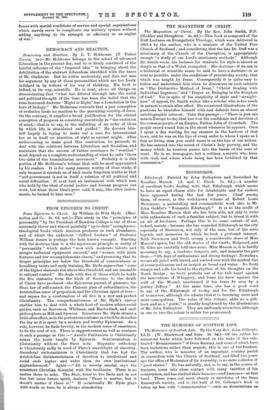Edinburgh. Painted by John Fulleylove and Described by Rosaline Masson.
(A. and C. Black. 7s. 6d.)—A number of excellent books dealing with that Edinburgh which seems to have an equal charm alike for inhabitants and for visitors have appeared during the last few years. Chief among them, of course, is the well-known volume of Robert Louis Stevenson ; a painstaking and commendable work also is Mr. John Geddie's " Romantic Edinburgh." It is to the credit of Miss Rosaline Masson that she has been able, not only to write with enthusiasm of such a familiar subject, but to invest it with an air of freshness. Perhaps this is to some extent—if not, indeed, mainly—because she has regarded Edinburgh as the city especially of Stevenson, not only of the man, but of the eerie legends and memories in which he took a profound interest. Both Stevenson and Scott occupy a considerable share of Miss Masson's space, but the old stories of the Castle, Holyrood, and St. Giles are carefully told once more. Miss Masson is, it is hardly necessary to say, a iaudator temporis acti, and laments the past thus :—" Oh days of enthusiasms and strong feelings! Nowadays, we are all jaded with travel, and washed over with the neutral tint of cosmopolitanism and as insipid as bread and water. No Scott stamps and rolls his head to the rhythm of his thoughts on the North Bridge ; no Scott protests out of his full heart against the innovations of Whiggery, and leans his brow against the wall of the Mound, unashamed if his tears be seen by a jesting Jeffrey." At the same time, she has a good word to say of the Edinburgh of to-day and for the Edinburgh of to-morrow, although she admits that it is becoming more and more cosmopolitan. The value of this volume, alike as a gift- book and as a "guide," is greatly heightened by the illustrations of Mr. John Fulleylove. They are uniformly attractive, although in one or two the colour is rather too pronounced.






















































 Previous page
Previous page